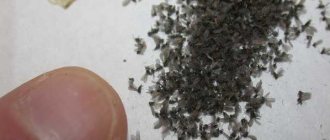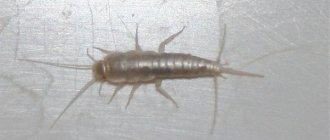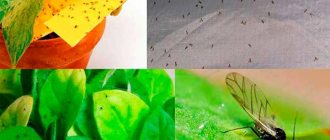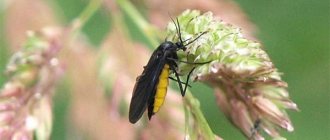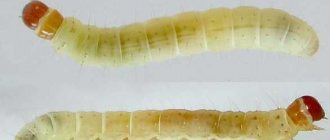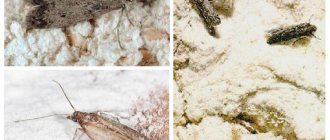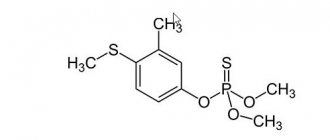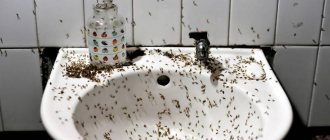As the harvest season begins, many are looking for a way to get rid of fruit gnats. These small annoying insects do not cause serious harm, but they can spoil food and nerves. There are many ways to combat these pests: poisonous sprays, traps, a rich arsenal of folk remedies. Let's find out how insects get into the house, what to do to prevent their appearance, and how to remove fruit flies from an apartment or private house.
Where do insects come from in the kitchen?
The fruit midge is a small black or brown insect that, like the house moss, belongs to the order Diptera. These insects feed on plant fruits that have begun to deteriorate and rotting plant matter. On warm summer days, they can appear in the kitchen, starting in a bag of fruit or in a trash can. To fight these insects, you need to understand where they come from and how they get into the house.
Even the cleanest home is not immune from infection with fruit flies. Flies appear from eggs laid by adult insects on fruits while they are still ripening. Then the fruits are picked, brought into the house and stored, forgetting to wash. There is now enough heat for the rotting process to begin. The eggs will then hatch into larvae to feed on the rotting mass and develop into adult flies.
There are other ways of infection:
- Invasion of flies from the yard through a window or ventilation ducts. This path is especially relevant for private houses. If there are apple trees or other fruit trees in the yard, it is necessary to promptly remove rotting fruits from under them. Otherwise, fruit flies will appear on the rotting remains and fly into the home in search of food.
- Insects enter the house along with contaminated soil. Flower pots are often where midges appear. Soil that has been fertilized with humus is especially dangerous.
To avoid the proliferation of fruit flies in flower pots, do not use “spent” tea leaves to feed plants. Rotting tea leaves are an attractive environment for insects to appear.
Knowing the ways in which midges enter your home, it is easier to organize effective prevention of infection.
Main types of pests
Midges in the country are an unpleasant fact that cannot be predicted in advance. You never know which pest will be a bothersome guest in your garden beds this coming summer.
White midges (whitefly)
Midges on cucumbers and other crops can appear both in the garden and in the greenhouse, and sometimes even manage to end up right in the house.
The whitefly feeds on plant sap, which causes their death. In addition, it secretes a special substance, which, settling on the leaves, leads to the formation of the so-called sooty fungus, which interferes with normal air exchange and photosynthesis. Plants become covered with a sticky crust, turn black and die.
Whiteflies are often carriers of a variety of diseases, which they transmit to healthy plants.
Whitefly
Black midges (melon aphid)
This insect is one of the most dangerous pests in gardens, affecting cucumbers and other crops.
On plants affected by aphids, the leaves curl and dry out. The processes of photosynthesis and nutrient formation slow down. The fruits ripen much more slowly. Aphids can cause complete crop loss. In addition, it is also a carrier of viral diseases.
melon aphid
Mining flies
Mining flies, or miners, are small insects 2-3 mm long. When starting to lay eggs, the female pierces the leaf membrane with the sharp end of her ovipositor and lays eggs in soft tissue. 5 days later, the eggs hatch into larvae. They intensively gnaw plant tissue, making numerous passages in them, which are called mines. Hence the name - miners.
After two weeks, the larva pupates, having first moved to the ground and burrowed into it. After some time, an adult fly emerges from the pupa.
These midges pose a danger to many garden crops, often introducing themselves into them at the seedling stage. Punctures made by the miner and passages gnawed by the larvae violate the integrity of the leaves. The pest eats away the soft tissue of the leaves and drinks the sap of the plant, as a result of which the plant gradually dies.
Mining front sight
Cabbage fly
The cabbage fly threatens not only cabbage, but also other vegetable crops. The flight of midges coincides with the timing of planting cabbage in the ground. After a few days, mating occurs. The midge lays up to 150 eggs in small groups at the roots of cabbage, as well as in the soil near the plant.
The greatest damage is caused by the first generation cabbage fly larvae. Early cabbage varieties suffer the most from midges. The first sign of the presence of cabbage fly larvae in cabbage roots is stunted growth and wilted leaves. The larvae damage the root from the inside, which leads to disruption of the supply of nutrients to the above-ground part of the plant.
Cabbage fly
Preventing the appearance of fruit flies
To prevent a whole swarm of annoying midges from appearing in your apartment, you need to make it as unattractive as possible for insects as a breeding place. The following measures will help with this:
- Destruction of food supply. The trash can must be tightly closed with a lid and removed promptly. Any fruit that has begun to spoil should be thrown away without any pity - or the spoiled parts should be removed. Also, preventive measures include timely removal of food from the table, proper storage of flour and cereals (closed containers, timely disposal of spoiled foods, etc.).
- Elimination of water sources. Like other pests, fruit flies need a source of moisture. A leaking faucet, a dripping pipe joint, or even a constantly damp cleaning rag will do the trick. Remove all sources of liquid and your home will become much less attractive to midges.
- Maintaining good hygiene. Before storing fruits and berries brought into the house, they must be washed to remove insect eggs from them. Then the fruits are dried and placed in plastic bags. In addition, important preventive measures are wet cleaning, garbage disposal, and timely washing of dishes.
- Blocking access from the street. All opening windows are covered with mosquito nets. Mesh screens are also placed on ventilation vents.
We recommend: How to make chops with a regular hammer and fork
Following these rules will help protect your home from fruit flies entering your home. If an infestation is discovered, it is necessary to take urgent measures: find a place where flies are hatching (usually a can of cereal, a bag of rotten fruit or a flower pot) and carefully dispose of spoiled food along with the flies.
Why are fruit flies dangerous?
Attitudes towards fruit flies range from complete disdain to unjustified fear. They are practically safe for humans: they do not bite and do not cause allergies. But the appearance of these insects in the house has several harmful consequences:
- Flies carry the remains of rotten fruit along with bacteria on their legs. Once in food, these bacteria multiply quickly, which leads to food spoilage. Rotten products accumulated in spoiled food can cause food poisoning.
- An annoying midge, flickering in front of the face, landing on the skin, crawling into the eyes and nose, can quickly drive even the most patient person to white heat. Since fruit flies do not feed on blood, humans are not particularly attracted to these insects. But with a strong infestation, the intrusiveness of fruit flies already turns into a problem.
The fruit fly is a popular subject for study in genetics. Thanks to her, many fundamental laws of nature were discovered. But outside the scientific laboratory, this insect does more harm than good.
Despite the relative harmlessness of Drosophila, you should not hesitate to start the fight. The more time passes from the moment the infestation is discovered, the greater the hordes of flies you will have to fight.
What you need to know about fruit flies
Midges do not harm human health, but if they are accidentally swallowed, infection can occur in housing and communal services. Midges are surprisingly prolific, with one female laying more than 1,500 eggs. From larvae, insects become adults in just a week. Pests can spoil the mood of residents for two months.
Drosophila get into housing in the following ways:
- on shoes;
- with food;
- on animal fur;
- through the windows.
Pests eat decaying organic matter. A population can be started by the smallest piece of food or spilled liquid. They often swarm near trash cans, rotten fruits, and animal feed. They are not afraid of frost. Most of all they love moisture and alcohol.
Drosophila - fruit flies - love fruits, especially citrus fruits. Because of this, the fruits receive physical damage. Soft fruits may become completely unusable. You can often find moths in dried fruits.
Fruit midges usually appear in apartments in the summer
The best household chemicals to combat midges
The chemical industry produces many varieties of insecticides and insect repellents. Some of them can also be used to combat fruit flies.
Here are some of the most effective drugs:
- Liquid for fumigator "Kombat". The reservoir with liquid is screwed to the fumigator, then the device is connected to the power supply. The fumigator releases vapors that have an insecticidal effect. In addition to midges, the drug will get rid of mosquitoes and flies. The product acts quickly (the effect is noticeable within an hour) and is affordable. A bottle of liquid costs about 300 rubles.
- Raptor trap with sticky inside. A bait solution is supplied with the trap. It is enough to pour a small amount of solution into the trap and place it in a place where insects accumulate. One trap is enough to effectively protect a room of 10 square meters. m for a month. At the same time, the outside of the trap remains clean and does not spoil the interior of the kitchen. The price of the set is about 150 rubles.
- Aerosol "Dichlorvos". A powerful, effective insecticide containing cypermethrin and tetramethrin. In most cases, a single treatment is enough to get rid of fruit flies. However, the product is not safe for health - after spraying and exposure, the room must be thoroughly ventilated.
We recommend: Dichlorvos neo odorless: instructions for use
Kitchen cleaning requires special care to ensure that the insecticide does not get into drinking water or food. Before spraying, place all products in tightly closed containers and hide them in a closet. Flowers and pets are also removed from the kitchen, and children and elderly family members are prohibited from entering the premises during treatment.
Folk remedies: cheap and safe
The use of industrial insecticides is justified as “heavy artillery” - as a last resort in case of severe infestation. In other cases, it is better to use safer folk remedies:
- Smelling foods have a good effect in the fight against fruit flies: garlic, cloves, orange peel, vinegar.
- Indoor plants that emit strong odors, such as geraniums, will help.
- Another helper is tape with an adhesive surface.
- A homemade poisonous composition gives a good effect: half a glass of milk, 40 g of sugar, 40 g of black pepper. Saucers with the solution are placed in places where flies accumulate.
We recommend: Dishwasher versus aluminum pan: why is it better to wash such dishes by hand?
Often these products are sufficient to combat fruit flies.
How to remove fruit flies using traditional methods
A good remedy against these insects is ordinary table vinegar. To do this, all cabinets and shelves for storing food are washed with soapy water. Then all surfaces are wiped with a solution of table vinegar. Additionally, strong-smelling substances are placed in areas where fruit flies accumulate. Garlic cloves, orange peels, and lavender leaves are suitable for this.
Camphor aroma works well against fruit flies. Camphor is crushed into pieces and fried in a dry frying pan. When smoke starts, remove the container from the heat and carry it through all the rooms. In rooms where flies accumulate more than other rooms, it is worth staying longer. Camphor is not dangerous for people and animals. Therefore, there is no need to remove anyone from the apartment before such treatment.
How to make a trap with your own hands?
You can make an effective fruit gnat trap yourself. Place a piece of apple, apricot or other sweet bait at the bottom of the glass jar. A sheet of paper folded into a funnel is inserted into the neck; a hole with a diameter of 3 mm should remain in its lower part). The flies will begin to make their way into the jar towards the bait, but will no longer be able to get out.
Getting rid of a brood of fruit flies is quite simple. The main thing is to notice the infection in time and take action quickly. Then the insects can be defeated using homemade traps or folk remedies. And, of course, do not forget about prevention. Throw away rotten fruits in a timely manner, do not forget about cleaning - and fruit flies will not become a problem for your home!
